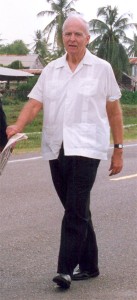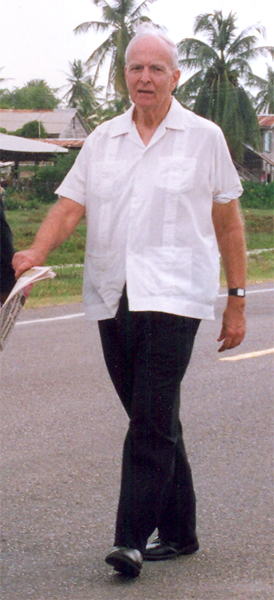David de Caires: a true connoisseur of the arts
So jail me quickly, clang the illiterate door
If freedom writes no happier alphabet.
(Martin Carter)
Anna Benjamin quotes David de Caires as expressing great concern for the quality and integrity of his newspaper editorials because “these are what give a paper its character” and that “newspapers were judged by their tone” which the editorials tend to set. (Freedom of Expression and the Birth of Stabroek News, 2007). And it is said that de Caires finally discovered his mission in life, not in the law for which he was trained, but in publishing and editing, for which he had a sustained interest and commitment. He continued to be convinced that publications with the right tone, character and content could elevate and make a difference to the timbre of a society. The arts, he believed, was a necessary part of this influence.
This week we briefly highlight elements of the activities and persuasions of David de Caires that made a contribution to the arts or otherwise impacted or advanced them.

Orpheus, the mythical Greek musician and poet, had such outstanding mysterious talent that his performances entranced all and could disarm and transform the vilest of beasts. de Caires thus believed in the arts and their possession of that Orphic quality. The history of his activities testifies to the high place in which he perceived them in the political and social contexts. Benjamin observes that, despite their being somewhat different types of periodicals, it was his desire that the same structure with a segment reserved for arts and culture used for the New World publications should be repeated in the Stabroek News.
Much of this cultural preoccupation is reflected in his articles which include his tribute to Martin Carter in the journal Kyk-Over-Al and in Stewart Brown’s The Art of Martin Carter (2000); “The New World Group in Guyana” 2005, (paper delivered to the Conference of the Centre for Caribbean Thought); as well as his contributions to New World Quarterly (1963) and New World Fortnightly (1964 – 1967). Those periodicals represent both his first venture into editing and publishing and part of the important achievements, lasting contributions that he has made to the fields of literature, cultural and political affairs.
Benjamin also relates how de Caires and his partner in legal practice, Miles Fitzpatrick, became involved in the New World group in 1960-61 including the time and intellectual energy devoted to cultural discourse, political, public and regional affairs. He became initiated in poetry and cultural affairs in similar fashion. In his published tribute to Carter, and in oral presentations on the same subject, de Caires tells of his orientation into the world of the poet Carter and his colleagues who were immersed in a culture of regular, statutory meetings for sessions of poetry readings and intellectual discussions. These sessions must have been going on for more than a decade before de Caires joined them, because Edgar Mittelholzer had already immortalized them in a poem, describing them in very much the same way that de Caires does. Mittelholzer writes of all the various poets and topics interrogated, but repeats the refrain “always there was rum”. More than the lines of Yeats and Eliot, rum flowed by the flagons and the hogheads at those sessions, providing the young de Caires with an intoxicating love of poetry that hung over for the rest of his life.
Carter, who he admired, became one of his favourite poets. They also had a long association which included two very important contributions to Carter’s career and to Caribbean poetry. The first is described by de Caires himself in Benjamin’s Birth of Stabroek News. The New World Fortnightly had “the great good fortune to publish five original poems of the late poet Martin Carter, who gave them to us not long after we started, under the general title ‘Jail Me Quickly’. They rank among his best known work”. Indeed, “Jail Me Quickly” is an important group of poems with “Black Friday 1962”, followed by “After One Year” being among Carter’s best and most famous. The other three are a bit less known; “What Can a Man Do More?”, “Where Are Free Men?” and “Childhood of a Voice”. They contain the poet’s shock and repudiation of the bitter and murderous events of Guyana’s racial civil war of the early sixties. Their first release to the world in 1963 was surely a major contribution by New World. This, and other poems, habitually published in groups by Carter, eventually appeared in Poems of Succession in 1977.
Much later, de Caires and Fitzpatrick were to make another major contribution to the poetry in 1989. By this time, Carter’s work was out of print and universities, scholars, researchers and general readers were complaining that they had tremendous difficulty accessing this poet. His reputation across the Caribbean was by this time considerable, yet the unavailability of his books was certainly a factor in
the limited exposure of the work to an
international audience. Another new group known as Demerara Publishers decided to alleviate the situation by collecting the three books together under one cover and publishing them as Selected Poems.
Selected Poems won the Guyana Prize for Literature in 1989 and the work of a foremost Caribbean writer was once again in circulation.
However, while that risk paid dividends, it was another risk that had closed down New World Fortnightly more than a decade earlier. Buoyant with the spirit of Independence the New World group planned a special issue conceived as a magnum opus with the distinguished George Lamming as a guest editor. Inspired by Lamming’s artist’s optimism, zeal prevailed over business sense causing an over-ambitious production and an unrealistic number of copies to be printed. Already struggling financially, the magazine did not recover from that, and ceased production.
But these are progressive times, and Guyana Publications Incorporated, the company formed to publish the Stabroek News, produced 100 Cartoons by Hawley Harris who was in his time the best in the Caribbean. More recently it produced Anna Benjamin’s Freedom of Expression and the Birth of Stabroek News and Guyana and the World – Selected Editorials by Lloyd Searwar, edited by Barton Scotland.
The same unqualified love for literature that made it possible for de Caires to succumb to the risky temptations afflicted him with a deep concern for the health and preservation of national arts and culture. In these areas he made further significant contributions that have remained unsung. On one of his sojourns in London, he discovered that a sizeable volume of Guyanese treasure was buried in a basement there. Several paintings by the great Aubrey Williams were lying in a damp basement room in the home of his widow and it was beyond her means either to store and conserve them properly or to find profitable new homes for them.
de Caires decided to plot a scheme to rescue the endangered art. With his characteristic thoroughness, he designed an instructive and persuasive exercise. He planned a party at his house to which he invited a number of Guyanese, a mixture of the philistine and the culturally sensitive. One necessary factor that united them, however, was that they were all, to use his description, “seriously rich”. He brought Stanley Greaves over from Barbados to give an illustrated lecture on the art of Aubrey Williams. The idea was to fete, educate, inspire and otherwise appeal to them to purchase some of the paintings and perhaps contribute to their conservation and ‘repatriation’ (they were, in fact, painted in England). The guests were wealthy enough to buy the art; the party was an appeal to persuade them.
There were many other voluntary activities undertaken by David de Caires for art’s sake. When the nation’s theatrical heritage was threatened he responded by initiating and leading a committee to raise funds to restore the crumbling Theatre Guild. He once again appealed to the ‘seriously rich’ and got satisfactory responses from a wide range, which saw the Playhouse rebuilt.
He had earlier led a team to reform the Camp Street ‘avenue’ and went further to organise public lectures and demonstrations in that outdoor street setting. Yet again, literary instruction was one of his priorities and literature was one of the subjects of the occasional lectures. Among the most memorable was a presentation on Wilson Harris by one of the leading authorities on the subject, Michael Gilkes.
In similar fashion he agreed to a suggestion to have Stabroek News sponsor cultural events held at the Theatre Guild. These included readings to celebrate World Poetry Day in collaboration with the University of Guyana as well as public lectures. One of these presented Rupert Roopnaraine speaking on English novelist Charles Dickens. de Caires was equally open to the series of weekly poetry sessions at the Upscale Restaurant in Georgetown. At a special session to honour Martin Carter and his widow Phyllis, he read poems and gave a talk on his experiences with the poet. Informed and analytical attention to the arts has always been an occasional focus in the newspaper editorials and to celebrate the Upscale experiment, one of these leaders was titled “Let A Thousand Poems Bloom”.
The words of his favourite poet may quite fittingly be quoted in tribute to David de Caires. They are relevant to his love of the verse, his way with words and his unrelenting energy in the cause of literature and its functioning as “a mender of bad soles (souls)”. The words are equally relevant to the uncompromising fight for the preservation of free speech and unfettered expression that de Caires shared with Carter. They are taken from the poem “After One Year”, the second in the group of five that were first published in the New World Fortnightly. In fact, the title of the group was taken from these lines for their expression of the shocking state of affairs articulated by the poet at what he perceived as censoring impediments to free expression and human atrocities in the nineteen sixties.
So jail me quickly, clang the illiterate door
if freedom writes no happier alphabet.
They relate just as neatly to the mission that de Caires set himself in contemporary times.
The Sunday Stabroek ‘Arts on Sunday’ wishes to extend these words as an expression of solidarity with the immediate family of David de Caires — Doreen, Isabelle and Brendan.

